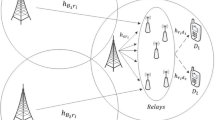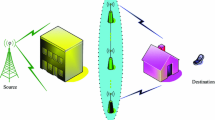Abstract
In this paper, we propose a novel spectrum-efficiency (SE) optimization scheme for amplify-and-forward (AF) cooperative relaying systems based on non-orthogonal multiple-access (NOMA). In this network, a weighted-sum-minimum mean-squared-error (WSMMSE) method is utilized to transform the original non-convex optimization problem into a tractable optimization problem. Then, the relay beamforming-matrix (BM) and the power-allocation (PA) coefficients are alternately optimized by use of the iterative beamforming method and the Lagrange-multiplier (LM) method subject to the quality-of-service requirements. Monte Carlo simulation results verify that our proposed new scheme can attain better performance than the optimal PA-NOMA technique and the conventional orthogonal multiple-access (OMA) technique.






Similar content being viewed by others
Data availability
The datasets generated during and/or analysed during the current study are available from the corresponding author on reasonable request.
References
Ding, Z., Liu, Y., Choi, J., Sun, Q., Elkashlan, M., Chih-Lin, I., & Poor, H. V. (2017). Application of non-orthogonal multiple access in LTE and 5G networks. IEEE Communications Magazine, 55(2), 185–191.
Islam, S. M. R., Avazov, N., Dobre, O. A., & Kwak, K. (2017). Power-domain non-orthogonal multiple access (NOMA) in 5G systems: Potentials and challenges. IEEE Communications Surveys Tutorials, 19(2), 721–742.
Ding, Z., Lei, X., Karagiannidis, G. K., Schober, R., Yuan, J., & Bhargava, V. K. (2017). A survey on non-orthogonal multiple access for 5G networks: Research challenges and future trends. IEEE Journal on Selected Areas in Communications, 35(10), 2181–2195.
Kilzi, A., Farah, J., Abdel Nour, C., & Douillard, C. (2020). Mutual successive interference cancellation strategies in NOMA for enhancing the spectral efficiency of CoMP systems. IEEE Transactions on Communications, 68(2), 1213–1226.
Ling, B., Dong, C., Dai, J., & Lin, J. (2017). Multiple decision aided successive interference cancellation receiver for NOMA systems. IEEE Wireless Communications Letters, 6(4), 498–501.
Molina, F., & lvarez, J.S.-A. (2020). Asymptotic performance analysis of successive interference cancellation with dynamic user-decoding order. IEEE Communications Letters, 24, 2931–2935.
Ahmed, A., Elsaraf, Z., Khan, F. A., & Ahmed, Q. Z. (2021). Cooperative non-orthogonal multiple access for beyond 5G networks. IEEE Open Journal of the Communications Society, 2, 990–999. https://doi.org/10.1109/OJCOMS.2021.3075081.
Liaqat, M., Noordin, K. A., Latef, T. A., & Dimyati, K. (2020). Power-domain non orthogonal multiple access (PD-NOMA) in cooperative networks: An overview. Wireless Networks, 26(1), 181–203.
Zhong, C., & Zhang, Z. (2016). Non-orthogonal multiple access with cooperative full-duplex relaying. IEEE Communications Letters, 20(12), 2478–2481.
Liau, Q. Y., & Leow, C. Y. (2019). Successive user relaying in cooperative NOMA system. IEEE Wireless Communications Letters, 8(3), 921–924.
Kara, F., & Kaya, H. (2019). On the error performance of cooperative-NOMA with statistical CSIT. IEEE Communications Letters, 23(1), 128–131.
Zaghdoud, N., Mnaouer, A. B., Boujemaa, H., & Touati, F. (2020). Secrecy performance analysis of cooperative NOMA system with multiple DF relays. In 2020 International wireless communications and mobile computing (IWCMC) (pp. 2160–2163).
Yue, X., Liu, Y., Liu, R., Nallanathan, A., & Ding, Z. (2017). Full/half-duplex relay selection for cooperative NOMA networks. In 2017 IEEE global communications conference (GLOBECOM) (pp. 1–6).
Yang, K., Yan, X., Wang, Q., & Qin, K. Y. (2021). DSWIPT scheme for cooperative transmission in downlink NOMA system. Mobile Networks and Applications, 26, 609–619.
Liu, Q., Lv, T., & Lin, Z. (2018). Energy-efficient transmission design in cooperative relaying systems using NOMA. IEEE Communications Letters, 22(3), 594–597.
Shen, Z., Liu, G., Ding, Z., Xiao, M., Ma, Z., & Yu, F. R. (2019). Optimal power allocations for 5G non-orthogonal multiple access with half/full duplex relaying. In 2019 IEEE international conference on communications (ICC) (pp. 1–7).
Bae, J., & Han, Y. (2019). Joint power and time allocation for two-way cooperative NOMA. IEEE Transactions on Vehicular Technology, 68(12), 12443–12447.
Obeed, M., Dahrouj, H., Salhab, A. M., Zummo, S. A., & Alouini, M. S. (2020). User pairing, link selection and power allocation for cooperative NOMA hybrid VLC/RF systems. IEEE Transactions on Wireless Communications, 20, 1785–1800.
Fang, F., Cheng, J., & Ding, Z. (2019). Joint energy efficient subchannel and power optimization for a downlink NOMA heterogeneous network. IEEE Transactions on Vehicular Technology, 68(2), 1351–1364.
Wang, W., Tang, J., Zhao, N., Liu, X., Zhang, X., Chen, Y., & Qian, Y. (2020). Joint precoding optimization for secure SWIPT in UAV-aided NOMA networks. IEEE Transactions on Communications, 68(8), 5028–5040.
Zhao, N., Li, Y., Zhang, S., Chen, Y., Lu, W., Wang, J., & Wang, X. (2020). Security enhancement for NOMA-UAV networks. IEEE Transactions on Vehicular Technology, 69(4), 3994–4005.
Yuan, C., Tao, X., Ni, W., Li, N., Jamalipour, A., & Liu, R. P. (2020). Joint power allocation and beamforming for overlaid secrecy transmissions in MIMO-OFDM channels. IEEE Transactions on Vehicular Technology, 69(9), 10019–10032.
Mohammadi, M., Chalise, B. K., Hakimi, A., Mobini, Z., Suraweera, H. A., & Ding, Z. (2018). Beamforming design and power allocation for full-duplex non-orthogonal multiple access cognitive relaying. IEEE Transactions on Communications, 66(12), 5952–5965.
Sun, X., Yang, N., Yan, S., Ding, Z., Ng, D. W. K., Shen, C., & Zhong, Z. (2018). Joint beamforming and power allocation in downlink NOMA multiuser MIMO networks. IEEE Transactions on Wireless Communications, 17(8), 5367–5381.
Xue, C., Zhang, Q., Li, Q., & Qin, J. (2017). Joint power allocation and relay beamforming in nonorthogonal multiple access amplify-and-forward relay networks. IEEE Transactions on Vehicular Technology, 66(8), 7558–7562.
Boyd, S., & Vandenberghe, L. (2004). Convex optimization. Cambridge University Press.
Grant, M., & Boyd, S. (2014). CVX: MATLAB software for disciplined convex programming, version 2.1.
Sturm, J. F. (1999). Using SeDuMi 1.02, a MATLAB toolbox for optimization over symmetric cones. Optimization Methods and Software, 11(1–4), 625–653.
Cheng, Y., & Pesavento, M. (2012). Joint optimization of source power allocation and distributed relay beamforming in multiuser peer-to-peer relay networks. IEEE Transactions on Signal Processing, 60(6), 2962–2973. https://doi.org/10.1109/TSP.2012.2189388.
Gupta, A., Biswas, S., Singh, K., Ratnarajah, T., & Sellathurai, M. (2018). An energy-efficient approach towards power allocation in non-orthogonal multiple access full-duplex AF relay systems. In 2018 IEEE international workshop on signal processing advances in wireless communications (SPAWC).
Acknowledgements
This work was supported by the National Natural Science Foundation of China under Grant No. 61801093.
Author information
Authors and Affiliations
Corresponding author
Additional information
Publisher's Note
Springer Nature remains neutral with regard to jurisdictional claims in published maps and institutional affiliations.
Rights and permissions
About this article
Cite this article
Yang, K., Yan, X., Wang, Q. et al. Spectral-efficiency optimization for NOMA-based amplify-and-forward cooperative relaying systems with beamforming and power allocation. Wireless Netw 27, 4123–4132 (2021). https://doi.org/10.1007/s11276-021-02733-9
Accepted:
Published:
Issue Date:
DOI: https://doi.org/10.1007/s11276-021-02733-9




